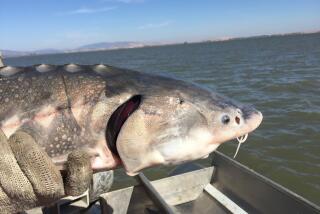Grunion on the Run : By the Light of the Silvery Moon, Hunters Stalk Frolicking Fish
- Share via
NEWPORT BEACH — A line of people stood silently on the beach just south of Newport Pier, watching the water for any sign of life.
Slowly it began to appear. With an eerie sort of flickering, a tiny white object flapped helplessly on the moonlit beach between the waves. In a minute there were more. Then more. Soon a city of small shining fish covered the wet sand like a shimmering jacket made of silver.
The observers broke ranks and pounced in the mud with buckets and flashlights in hand.
Another grunion run was in progress. The frenzy had begun.
This annual vision in the sand along Pacific Coast Highway is a sight so unusual that thousands flock to see it each year. Many return disappointed, convinced that they have been fooled by their friends, victims in their own minds of the ultimate snipe hunt.
For those who see it, however, the experience is thrilling. These are the only fish in the world that spawn on land. Aside from a few isolated stretches of beach on the Gulf of California, the only place they do it is along the Pacific Coast from Southern California to Baja California.
The shimmering is the gleam of moonlight on the underbellies of living things.
“It’s incredible,” said Bob Gullage, 40, a jeweler from Yorba Linda out for his first grunion run. “When I first heard about this I thought it was a joke.”
“I’ve been doing this since I was 12,” said David Burton, 49. “It takes me back to my childhood.”
The 6-inch-long fish begin their mating ritual in early spring and repeat it at two-week intervals through the summer. Washing onto beaches in droves during peak tides, the females bury their tails to lay their eggs in the sand while the males wrap themselves around the upright bodies to deposit their sperm, or milt.
Once fertilized, the pinhead-sized eggs--as many as 3,000 per fish--lay incubating for two weeks. Then, stirred to life by the coming of the next high tide, they hatch into tiny grunion that are washed immediately out to sea to fend for themselves.
The American Indians knew of the fish, making reference to a small creature that made a grunting sound while on the beach. Some naturalists have also described the sound, attributing it to the egg-laying females. The word grunion is Spanish for grunter.
It is likely that the grunions’ tastiness was not lost on the early Indians.
Until 1927 it was open season on grunion. Then authorities, discovering that farmers were using nets to catch huge piles of the tiny fish for fertilizer, imposed restrictions. Today it is illegal to collect grunion anytime but in summer, and then only by hand.
Shining lights on the mud near the Newport Pier, people scanned the beach for their silvery prey.
Individual catches on this night ranged from a single grunion to as many as 14. Although some said they hoped to grab as many as possible, fry them up and throw huge grunion feasts for their friends, others admitted to being there just because they were curious.
Morgan Price, 17, and his friends had come intending to catch their dinner but the excitement of seeing their first grunion pair changed that.
“We just didn’t feel right about grabbing them while they were mating,” he said.
Grunion Biology
Name: Leuresthes tenuis
Relatives: Jacksmelt and topsmelt
Size: About six inches long
Description: Greenish, with a silver-blue side stripe and bluish blotch on cheek
Range: Point Conception, Calif., to Point Abreojos, Baja California
Spawning months: March through August
Life span: Three years
More to Read
Sign up for Essential California
The most important California stories and recommendations in your inbox every morning.
You may occasionally receive promotional content from the Los Angeles Times.













